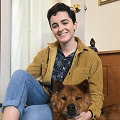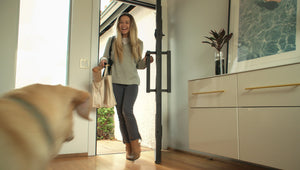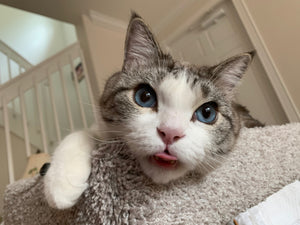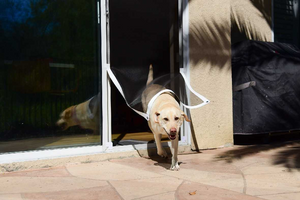Expert Tips for Training Your Dog to Use a Dog Door

A Guide to Cat Flap and Dog Door Training
If you've recently invested in a dog door, you're one step closer to enriching your pets’ lives! But before you can enjoy the benefits of giving your dogs and cats unrestrained access outdoors, you need to train them to use it.
That’s right. Not every pet will take to their pet door like ducks to water. If they aren’t taught how to step through the flap, your pet door may go unused forever. But with time and patience, you can definitely teach an old dog new tricks.
While we aren't professional dog trainers, we're pet door experts well-versed in the basics of dog training. Not only have we heard plenty of stories from frustrated pet parents who can’t get their pets to use their pet doors, but we have helped them give their pets the freedom they deserve.
Here are some dos and don'ts to guide you in your dog door training journey.
Consistency is Key
While pet training methods may vary, the golden rule remains: consistency. The adage “practice makes perfect" holds as true for obedience training as it does for learning any new skill.
Consistent training methods and using the same dog door throughout the training process will enable your dog to learn faster. Make time to train your dog every day to best enable them to succeed. Don’t forget to reward them for using their pet doors correctly with treats, pets, and playtime.
Stay Calm and Patient
Every dog is unique in its learning pace. If your dog needs extra time with their new door, maintain patience. Rushing them will only lead to confusion and frustration for all parties.
Instead of forcing your dog or cat through, start by familiarizing them with the door flap. Give them time to sniff the flap and get used to its presence. Demonstrate how it functions by lifting the flap up with your hands. If they're hesitant, position yourself outside the door and encourage them to approach using treats.
You may want to start by making the flap easier to use. This may mean using a training flap (like the training flap for Hale Pet Doors), removing any wind-resistant magnets, or removing the flap from the hinges completely. You can also prop the flap open with a chair.
Once your pet is used to the motion of going through the door, you can then upgrade them back to the normal flap-resistance levels.

Set a Time Limit
Limit each training session to approximately 10 minutes. While training is a great way to engage your pets, doing it for too long will only leave them frustrated. Plus, it’s more important that training sessions happen consistently as opposed to lasting a longer time.
If you really need to spend more than 10 minutes a day training your dog, you can split the training sessions up to multiple times throughout the day with enough time for your pets to relax in between.
Ensure the Door Flap is the Right Size
Before you commit to a dog door, make sure it's the appropriate size for your pet. An improperly fitting pet door is harder to use. No matter how much you train, it will discourage your pet from using their pet door.
The top of the pet door should be at least 1” higher than the tallest point of your pet’s back. Having the door too low will result in your pet scraping their back on the frame, which can cause injury.
At the same time, make sure that the pet door isn’t too high off the ground. Your pet should be able to comfortably step-over the lower edge of the pet door. A step-over that is too tall will be harder for your pet to use as they become older and lose mobility.
You can test out your pet door’s size by cutting a hole in a piece of cardboard the same dimensions as the flap. Try having your pet walk through the hole and observe how comfortable they are doing so. If anything scrapes or they trip, you will need a different pet door size or model.
You can learn more about how to measure your pet for a pet door with our measuring guide.
Different Door Flaps Require Different Approaches
If your pet had a dog flap previously, they may find it hard to adjust to having a new one, especially if the kind of flap is different. There are three characteristics of flaps that you need to look out for: clear flaps, magnetized flaps, and electronic flaps.
If you have a transparent, clear flap (like this flap for the Cat Mate Elite 305), your pet might mistake it for a window, especially if they have accidentally run into a sliding glass door before. You can help them distinguish the difference by applying masking tape to the outside of the flap.
Conversely, some pets have trouble going through flaps that are completely opaque (like the Pride Pet Door), as they think it is part of the wall. Lifting up the flap for them is a good way of showing that they can go through it.
Magnetized flaps like the one featured on the Endura Flap and the Dragon Pet Door might be weightier due to magnets lining their bottoms and sides. If possible, remove the magnets during the initial stages of training or assist your dog by holding the flap for them. You can add the magnets steadily back as they learn to use the door.
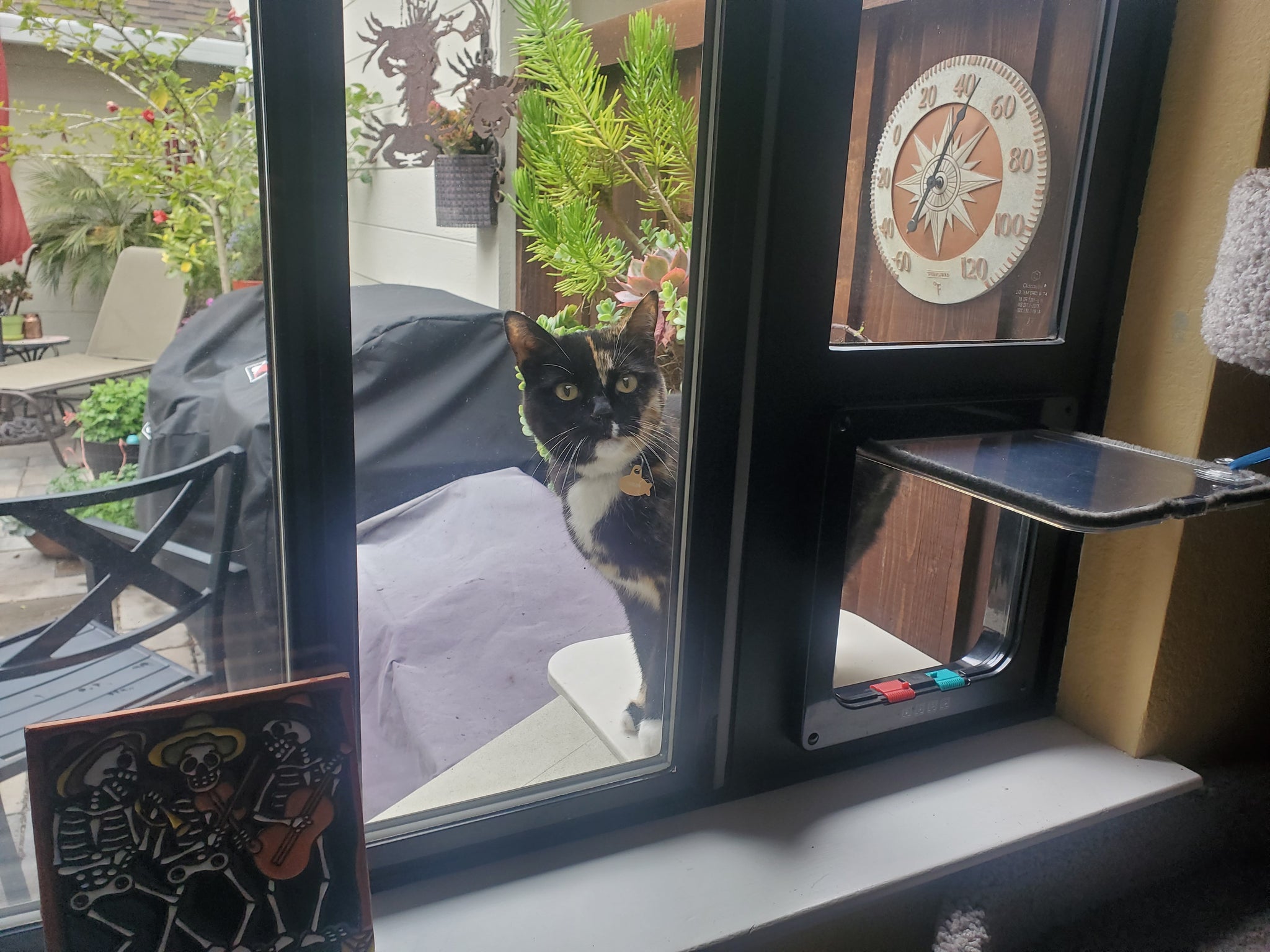
Electronic flaps are pet doors that are locked until its sensors detect your pet’s microchip or collar key. Then the sensor unlocks the flap for them. While electronic flaps are great for multi-pet households or for keeping critters out, they have the largest learning hurdle.
The motors that locks and unlock the door are noisy, which can spook your cat and dog. They have to be desensitized to them before they will feel comfortable using the flap. Once they know that they can go through the flap, they might still need to learn to wait for the sensor to activate. Repetition is the best way to teach your pets to go through the door on their own.
Training Mistakes to Avoid
Training your pets incorrectly can do more harm than not training them at all. To ensure that your pet has the best experience, make sure to avoid these bad habits:
- Overuse of Treats: While positive reinforcement is beneficial, excessive treats can diminish your dog's motivation. Gradually shift from treats to toy rewards or verbal praises.
- Excessive Emotion: Both positive and negative extreme emotions can confuse your dog. Maintain a calm and authoritative demeanor during training for optimal results.
- Inconsistency: Stick to a set training duration and method. Variability in either can lead to confusion and frustration for your dog.

Recap:
- Consistency in pet training is the golden rule; use the same dog door and regularly reward with treats or playtime for successful usage.
- Every dog and cat learns at their own pace, so familiarize them gently with the door flap, demonstrating its function, and using treats to encourage use.
- Training sessions should be kept around 10 minutes; if more time is needed, break the sessions up breaks where your pet can relax.
- It's essential to ensure the pet door fits your pet properly, with the top being 1” higher than their back and not too high off the ground; test door size with a cardboard cutout.
- Pets might find adjusting to different door flaps challenging, so be prepared to address issues with clear flaps, opaque flaps, heavy magnetized flaps, and electronic flaps.
- Avoid training mistakes like overusing treats; instead, transition to other rewards, and always remain calm and authoritative, ensuring consistent training methods and durations.
Remember to always reward successes and be persistent in your efforts. By avoiding common training mistakes, you'll ensure a smooth transition for your dog to its new door. Happy training!
